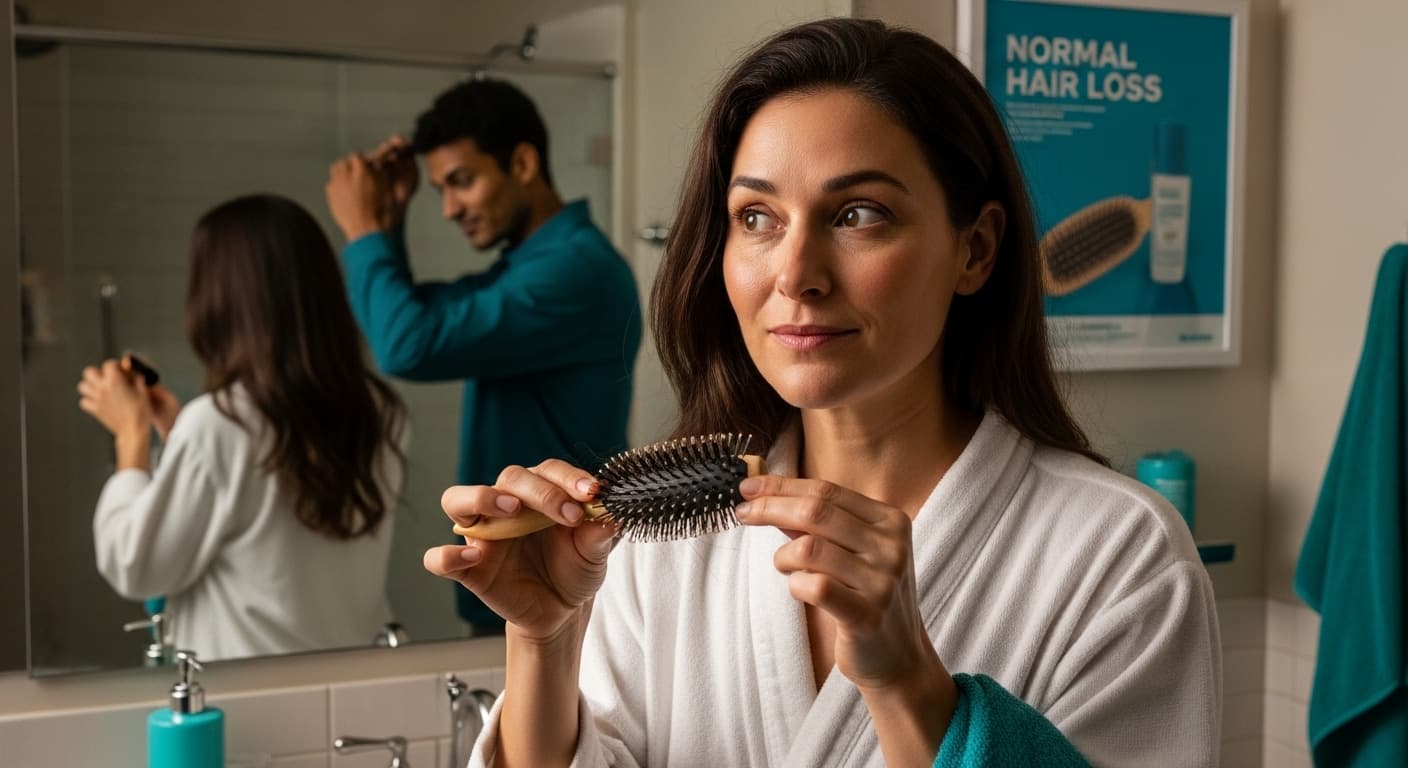Blog
Learning Materials
Understanding Normal Hair Loss Per Day: Key Insights
Updated: September 11, 2025

Most people do not think twice about the hair left behind on a brush or in the shower. You might expect that every strand matters, but science says otherwise. Shedding anywhere from 50 to 100 hairs per day is perfectly normal according to the American Academy of Dermatology and your body is designed for this cycle. The real surprise is how these tiny losses can actually reveal early clues about your overall health before you even notice other symptoms.
Table of Contents
- What Is Normal Hair Loss Per Day?
- The Importance of Tracking Hair Loss
- Biological Mechanisms Behind Hair Growth and Loss
- Factors Influencing Daily Hair Loss
- When to Consult a Professional About Hair Loss
Quick Summary
| Takeaway | Explanation |
|---|---|
| Normal hair loss ranges from 50 to 100 hairs daily. | Understanding this range is essential for identifying potential hair loss concerns. |
| Track hair shedding patterns for health indicators. | Regular monitoring can help reveal underlying nutritional or hormonal issues that may need attention. |
| Genetics and hormones significantly influence hair loss. | Recognizing hereditary patterns allows individuals to anticipate and manage their hair loss effectively. |
| Consult a professional for abnormal hair loss signs. | Early intervention can address underlying health issues linked to sudden or excessive hair shedding. |
| Maintain a detailed log for accurate diagnosis. | Keeping track of hair changes aids medical professionals in diagnosing and developing effective treatment strategies. |
What is Normal Hair Loss Per Day?
Understanding hair loss starts with recognizing what constitutes a normal shedding pattern. According to the American Academy of Dermatology, most individuals experience a predictable hair loss cycle that involves losing between 50 to 100 hairs daily.
![]()
The Natural Hair Growth Cycle
Hair follows a complex biological rhythm with three distinct phases that explain why normal hair loss occurs.
These phases include:
- Anagen (Growth Phase): Where hair actively grows and can last 2 to 7 years
- Catagen (Transition Phase): A short period where hair follicles shrink
- Telogen (Resting Phase): When hair naturally sheds to make way for new growth
This cyclical process ensures that hair continuously regenerates, with approximately 10% of your hair in the telogen phase at any given moment. When this percentage remains consistent, your hair loss is considered normal.
The table below compares the key phases of the natural hair growth cycle to help you understand how and why normal hair shedding occurs.
| Phase | Duration | Key Characteristics |
|---|---|---|
| Anagen (Growth) | 2-7 years | Active hair growth, majority of hair is in this phase |
| Catagen (Transition) | 2-3 weeks | Follicle shrinks, hair detaches from blood supply |
| Telogen (Resting) | 3-4 months | Hair sheds naturally, new growth prepares to emerge |
Factors Influencing Daily Hair Shedding
Multiple elements can impact how many hairs you lose each day. Genetics play a significant role, determining your individual hair density and shedding patterns. Hormonal changes, stress levels, nutrition, and overall health also contribute to hair loss variations.
If you're concerned about tracking your hair health, our guide on normal hair fall provides deeper insights into understanding your unique hair growth patterns. By recognizing what constitutes normal hair loss, you can better monitor potential changes and seek professional advice if needed.
The Importance of Tracking Hair Loss
Tracking hair loss is more than a cosmetic concern. According to Mayo Clinic, monitoring your hair shedding patterns can reveal critical insights into your overall health and potential underlying medical conditions.
Early Detection of Health Signals
Hair loss is not just about appearance but serves as a potential health indicator. Unusual shedding can signal various health issues such as:
- Nutritional Deficiencies: Low iron, protein, or vitamin levels
- Hormonal Imbalances: Thyroid disorders or changes in reproductive hormones
- Stress Indicators: Significant emotional or physical stress
By consistently tracking hair loss, you can identify these potential health markers before they escalate into more serious conditions. Proactive monitoring becomes a preventative health strategy.
Tools and Techniques for Tracking
Modern technology offers sophisticated methods for monitoring hair loss. Digital tracking tools can help record daily shedding, analyze patterns, and provide personalized insights. Hair loss solutions for tracking and treatment can help individuals develop a comprehensive understanding of their unique hair health profile.
Professional dermatologists recommend maintaining a detailed log of hair shedding, noting changes in texture, volume, and rate of loss. This documentation becomes invaluable for medical professionals in diagnosing potential underlying health conditions and developing targeted treatment strategies.
Biological Mechanisms Behind Hair Growth and Loss
Hair growth is a sophisticated biological process governed by intricate cellular interactions. According to research published in the International Journal of Trichology, hair follicles undergo complex molecular signaling that determines their growth, transition, and shedding phases.
Hair Follicle Life Cycle Dynamics
The hair growth mechanism involves three distinct phases that regulate how and when hair grows or falls out:
- Anagen (Active Growth Phase): Characterized by rapid cell division and active hair production
- Catagen (Transition Phase): Where hair follicle shrinks and detaches from blood supply
- Telogen (Resting Phase): When old hair falls out and prepares for new growth cycle
Genetic programming and hormonal signals precisely control these phases, ensuring continuous hair regeneration. Each hair follicle operates independently, which explains why not all hair falls simultaneously.
Molecular Regulators of Hair Growth
Multiple molecular factors influence hair growth and loss. Hormones like testosterone and dihydrotestosterone (DHT) play crucial roles in determining hair follicle behavior. Our guide on hair follicle growth provides deeper insights into these complex interactions.
Nutrients, stress levels, and overall health significantly impact these biological mechanisms. Disruptions in these molecular pathways can lead to altered hair growth patterns, potentially causing increased shedding or reduced hair production. Understanding these intricate biological processes helps individuals recognize normal versus abnormal hair loss patterns.
Factors Influencing Daily Hair Loss
Daily hair loss is not a random occurrence but a complex interplay of multiple physiological and environmental factors. According to Harvard T.H. Chan School of Public Health, understanding these influences helps distinguish between normal shedding and potential health concerns.
Genetic and Hormonal Influences
Genetics play a fundamental role in determining an individual's hair loss pattern. Some people are genetically predisposed to more rapid or extensive hair shedding. Hormonal changes can significantly impact hair loss, particularly during:
- Reproductive Transitions: Pregnancy, menopause, and puberty
- Hormonal Disorders: Thyroid imbalances and endocrine system disruptions
- Stress Hormone Fluctuations: Increased cortisol levels affecting hair growth cycles
Hereditary factors determine the sensitivity of hair follicles to hormonal changes, which directly influences daily hair loss rates.
Lifestyle and Environmental Factors
External elements dramatically impact hair shedding. Nutrition, stress levels, and daily habits contribute substantially to hair loss patterns. Our comprehensive guide on hair loss diet explores how nutritional choices influence hair health.
Physical and emotional stress can trigger temporary increased hair shedding. Nutritional deficiencies, particularly in iron, protein, and essential vitamins, can disrupt normal hair growth cycles. Environmental factors like pollution, extreme temperatures, and harsh hair treatments also play crucial roles in determining daily hair loss rates.
When to Consult a Professional About Hair Loss
Recognizing the difference between normal hair loss and potential medical concerns is crucial for maintaining optimal hair health. According to Penn Medicine, certain hair loss patterns warrant professional medical evaluation.
This table summarizes common warning signs of abnormal hair loss and the potential underlying health issues these symptoms may signal.
| Warning Sign | Possible Underlying Cause |
|---|---|
| Sudden or patchy hair loss | Autoimmune condition, stress, medical issue |
| Scalp skin changes | Inflammation, infection, dermatological issue |
| Accompanying physical symptoms | Hormonal imbalance, nutritional deficiency |
| Persistent loss >100 hairs/day | Underlying health or hormonal condition |
Warning Signs of Abnormal Hair Loss
Some indicators suggest you should seek professional medical advice about your hair loss:
- Sudden or Patchy Hair Loss: Unexplained bald spots or rapid shedding
- Scalp Skin Changes: Redness, scaling, or unusual inflammation
- Accompanying Physical Symptoms: Hair loss with unexplained weight changes, fatigue, or other health issues
Persistent hair loss beyond the normal 50-100 hairs per day could indicate underlying health conditions that require thorough medical investigation.
Diagnostic Approaches and Potential Interventions
Healthcare professionals use multiple diagnostic techniques to understand hair loss causes. Our guide on advanced hair treatment solutions provides insights into potential interventions.
A comprehensive medical evaluation typically involves detailed medical history, physical examination, and potentially blood tests to identify nutritional deficiencies, hormonal imbalances, or autoimmune conditions. Early professional consultation can help determine whether your hair loss is a temporary condition or a symptom of a more complex health issue, enabling timely and targeted treatment strategies.

Are You Unsure if Your Hair Loss is Normal? Get Personalized Answers Now
Worried your daily hair shedding might not be normal? As explained in this article, it can be tough to recognize if your hair loss is within the usual 50 to 100 hairs per day or a sign of a bigger issue. You already know how stressful it feels to see more hair in your brush or shower. Uncertainty about the cause keeps you guessing and searching for reliable answers. If you want real clarity instead of anxious guesswork, AI-powered assessment is the smartest next step. Read our guide on normal hair fall for detailed info, or go directly to the root cause with a scan.

Discover how your individual hair cycle stacks up with MyHair.ai, the platform that transforms your daily hair concerns into real insights using advanced technology. Upload a photo and get an instant, expert-backed evaluation on whether your shedding is typical for you. Benefit from personalized growth projections and tailored hair health tips to take control of your hair journey. Do not wait for more strands to fall before seeking peace of mind. Try the assessment today and start seeing your hair with new confidence.
Frequently Asked Questions
What is considered normal hair loss per day?
Most individuals typically lose between 50 to 100 hairs daily due to the natural hair growth cycle.
What factors can influence daily hair shedding?
Genetics, hormonal changes, stress levels, nutrition, and overall health can all impact how much hair you lose each day.
How can I track my hair loss effectively?
You can track hair loss by maintaining a detailed log of shedding patterns, noting changes in texture and volume, or using digital tracking tools designed for this purpose.
When should I seek professional help for hair loss?
You should consult a healthcare professional if you experience sudden or patchy hair loss, scalp skin changes, or any accompanying physical symptoms like unexplained weight changes or fatigue.